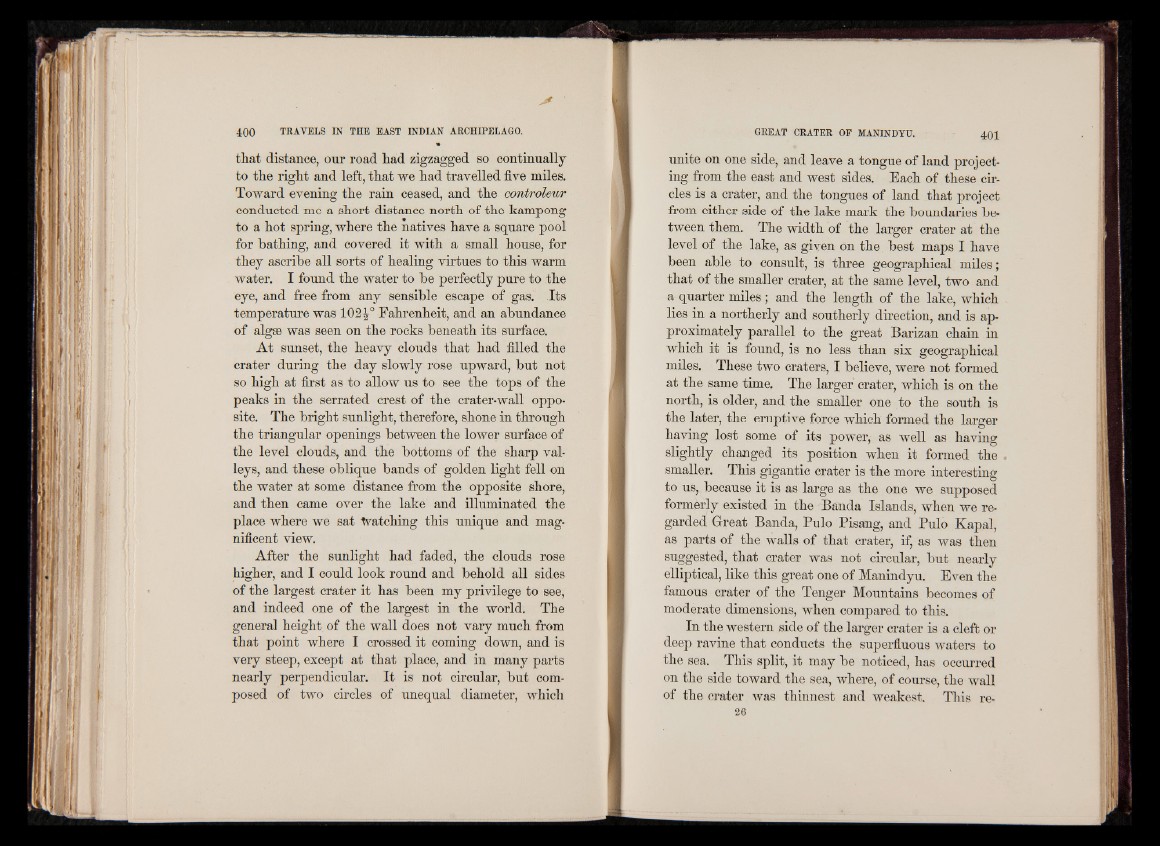
400 TRAVELS IN THE EAST INDIAN ARCHIPELAGO.
*
that distance, our road had zigzagged so continually
to the right and left, that we had travelled five miles.
Toward evening the rain ceased, and the contrôleur
conducted me a short distance north of the kampong
to a hot spring, where the natives have a square pool
for bathing, and covered it with a small house, for
they ascribe all sorts of healing virtues to this warm
water. I found the water to be perfectly pure to the
eye, and free from any sensible escape of gas. Its
temperature was 102J° Fahrenheit, and an abundance
of algæ was seen on the rocks beneath its surface.
At sunset, the heavy clouds that had filled the
crater during the day slowly rose upward, but not
so high at first as to allow us to see the tops of the
peaks in the serrated crest of the crater-wall opposite.
The bright sunlight, therefore, shone in through
the triangular openings between the lower surface of
the level clouds, and the bottoms of the sharp valleys,
and these oblique bands of golden light fell on
the water at some distance from the opposite shore,
and then came over the lake and illuminated the
place where we sat tvatching this unique and magnificent
view.
After the sunlight had faded, the clouds rose
higher, and I could look round and behold all sides
of the largest crater it has been my privilege to see,
and indeed one of the largest in the world. The
general height of the wall does not vary much from
that point where I crossed it coming down, and is
very steep, except at that place, and in many parts
nearly perpendicular. It is not circular, but composed
of two circles of unequal diameter, which
unite on one side, and leave a tongue of land projecting
from the east and west sides. Each of these circles
is a crater, and the tongues of land that project
from either side of the lake mark the boundaries between
them. The width of the larger crater at the
level of the lake, as given on the best maps I have
been able to consult, is three geographical miles;
that of the smaller crater, at the same level, two and
a quarter miles; and the length of the lake, which
lies in a northerly and southerly direction, and is approximately
parallel to the great Barizan chain in
which it is found, is no less than six geographical
miles. These two craters, I believe, were not formed
at the same time. The larger crater, which is on the
north, is older, and the smaller one to the south is
the later, the eruptive force which formed the larger
having lost some of its power, as well as having
slightly changed its position when it formed the .
smaller. This gigantic crater is the more interesting
to us, because it is as large as the one we supposed
formerly existed in the Banda Islands, when we regarded
Great Banda, Pulo Pisang, and Pulo Kapal,
as parts of the walls of that crater, if, as was then
suggested, that crater was not circular, but nearly
elliptical, like this great one of Manindyu. Even the
famous crater of the Tenger Mountains becomes of
moderate dimensions, when compared to this.
In the western side of the larger crater is a cleft or
deep ravine that conducts the superfluous waters to
the sea. This split, it may be noticed, has occurred
on the side toward the sea, where, of course, the wall
of the crater was thinnest and weakest. This re-
26